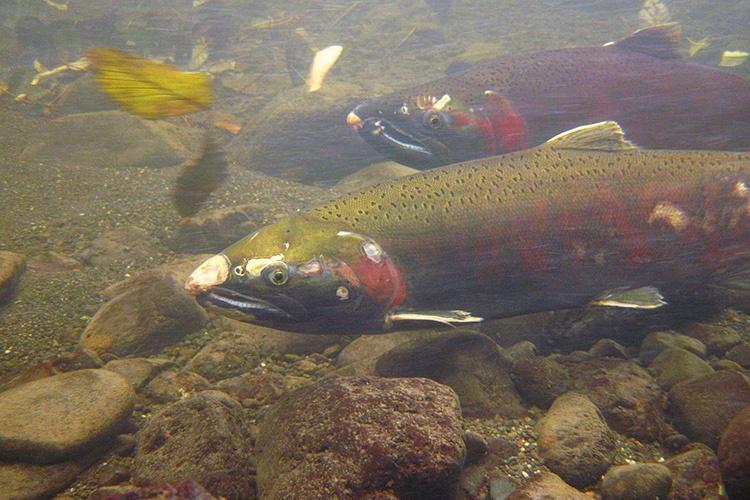
Recovering Pacific Salmon under the Inflation Reduction Act
by NOAA Fisheries 5 Feb 2024 22:15 UTC

Coho salmon © John R. McMillan / NOAA Fisheries
NOAA Fisheries received $27 million in funding under the Biden-Harris Administration's Inflation Reduction Act to help recover threatened and endangered Pacific salmon in the face of climate change.
NOAA is responsible for preventing salmon extinction and returning populations to healthy levels. U.S. West Coast salmon contribute to our culture, feed our families, and support jobs in the fishing fleet and beyond. They give back to the ecosystem as food for predators and by fertilizing watersheds with rich marine nutrients. Supporting Pacific salmon recovery is particularly beneficial to cultural heritage and livelihoods of Pacific Northwest tribes. Tribal traditional knowledge of Pacific salmon is vital to the conservation and restoration of the species. Twenty-eight West Coast salmon and steelhead groups are listed as threatened or endangered, from southern California to Washington State.
Learn more about pacific salmon and steelhead.
Using Science to Support Pacific Salmon Recovery
Each salmon species has a robust recovery plan developed through years of work and collaboration with communities and managers. Using the best available science, these plans identify actions needed to recover the species so they can again contribute fully to our communities, economies, and ecosystems. Recovering salmon depends on healthy and resilient habitats to support salmon at every life stage. But climate change and other threats make salmon recovery a complex and challenging task. Major climate threats include sea level rise, freshwater level fluctuations, hotter temperatures, changes in snowpack and snowmelt, flooding, and ocean acidification. The same actions that improve salmon resilience to these impacts can also increase human community resilience.
NOAA Fisheries received $27 million through the Inflation Reduction Act to support science to recover Pacific salmon. These funds will advance NOAA Fisheries' comprehensive strategy for Pacific salmon recovery by investing in science that will lead to improved management actions and substantial gains in salmon recovery. Our comprehensive strategy for recovery includes:
- Connecting habitat
- Ensuring water quality and quantity
- Managing fishing
- Investing in science
- Continuing production hatcheries
Robust science is critical to adaptively manage our rich and diverse Pacific salmon populations and address uncertainties in a changing climate. This funding will allow us to invest in the most effective solutions for each watershed along the West Coast. We can use what we've learned to make more informed decisions that have a big influence on Pacific salmon survival and, ultimately, recovery. We'll move Pacific salmon closer to healthy and harvestable levels that benefit our West Coast ecosystems, communities, and economies.
Through years of research, we've identified the challenges that prevent us from achieving healthy and harvestable Pacific salmon populations. However, we don't know enough about how the complex interactions between various factors affect salmon recovery within each watershed. We're still learning how habitat, water, predation, and other factors affect salmon populations' survival. Inflation Reduction Act funding provides an opportunity to fund important and impactful research in areas identified in our salmon science strategies:
Actions to Improve Salmon Science
We will fund prioritized salmon science actions in four areas:
Develop and Apply Integrated Models
These computer models simulate the interactions between different components of an ecosystem and predict salmon abundance. Improving models and producing more reliable predictions will help us develop better management strategies for the long-term survival of Pacific salmon.
Restoration, Reintroduction, and Recovery Techniques
Assessing successful and unsuccessful restoration methods will lead to meaningful conservation and management decisions. We will determine if reintroduced salmon can adapt to future environmental conditions.
Habitat Stressors in Freshwater and Estuary Environments
Pacific salmon use freshwater and estuary ecosystems habitats for spawning, rearing, migration, feeding, and overwintering. However, pollution poses a threat to these environments. We will investigate the impacts of stormwater pollutants on salmon and incorporate toxicity data into salmon management decision-making.
Ocean and Nearshore Ecology
Salmon spend most of their lives in the ocean, feeding until they reach maturity. Both predation and climate impacts on marine food webs pose significant threats to their survival in the ocean. Using advanced technologies, we will measure indicators of ocean productivity and predation rates to improve predictions of salmon survival and growth.
Within each focus area is a list of proposed projects and budgets. We will base project selection on responsiveness to the Climate-Ready Fisheries goals, feasibility, budget, and capacity maintenance and expansion.
Distribution of Pacific Salmon Funds
We have already allocated $42 million in support of Pacific salmon recovery.
Habitat Restoration Projects: $15 Million
We will use $15 million to support conservation efforts through the Pacific Coastal Salmon Recovery Fund. This funding, combined with other funding streams and multiple partners, will prioritize large-scale habitat restoration projects with transformational watershed and salmon population benefits.
High-Priority Science and Research Projects: $27 Million
Our two West Coast science centers will use Inflation Reduction Act funding to conduct science that supports transformative modeling to identify and prioritize high-impact restoration. The Northwest Fisheries Science Center received $16.2 million and the Southwest Fisheries Science Center received $10.8 million. We'll build on past efforts and transform our understanding of how habitat, climate change, and predation, and other factors affect salmon recovery. Specifically, we'll build quantitative decision-making tools to guide recovery and fill data gaps that make those tools more accurate.